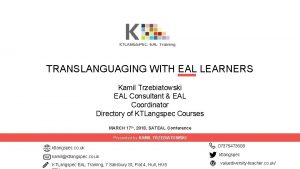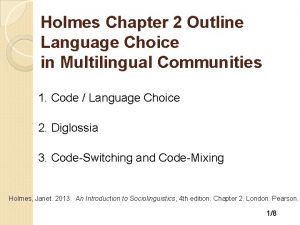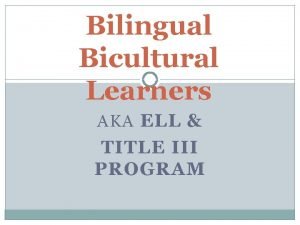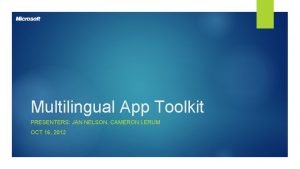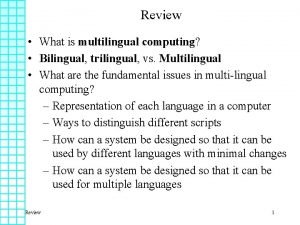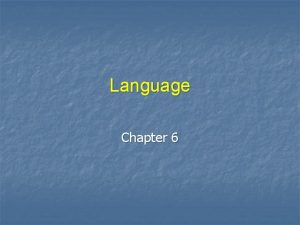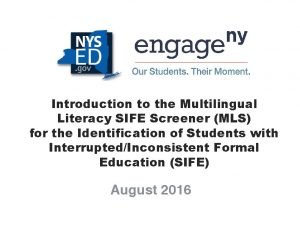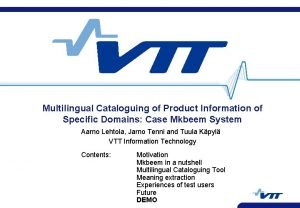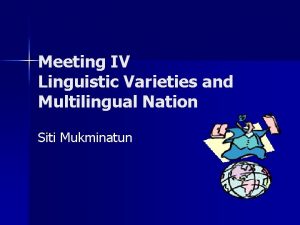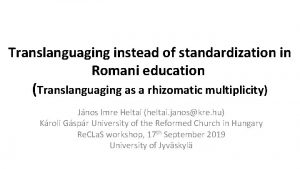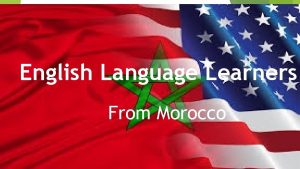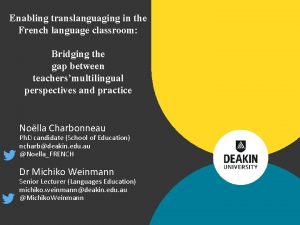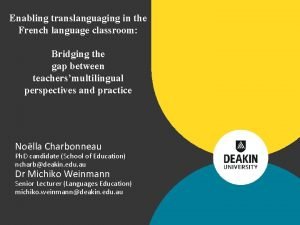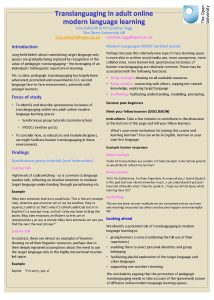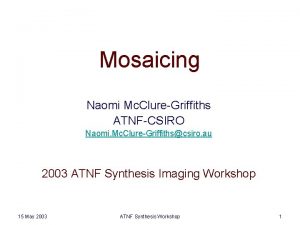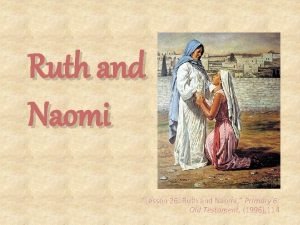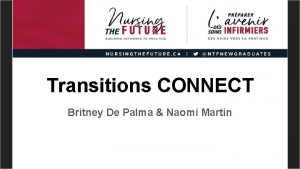Translanguaging with Multilingual Learners Naomi WilksSmith language s














- Slides: 14

Translanguaging with Multilingual Learners Naomi Wilks-Smith

language s

RMIT Classification: Trusted A primary school example 324 students More than 50% LBOTE 85 students in their first 5 years of English learning Somali Mandarin Hakha-Chin Tongan Oromo Korean

RMIT Classification: Trusted Bi-/multilingual learners • Use languages for various purposes & audiences • Languages are tools in learners’ communicative toolkits (Faulstich, 2015) • Languages are part of an interconnected system • Languages are often ‘left at the school gate’ (Wilks-Smith, 2017) • Languages are part of learners’ ‘virtual school bags’ (Thomson, 2002; Thomson & Hall, 2008)

RMIT Classification: Trusted Translanguaging • Brings languages into classrooms • Uses learners’ full “linguistic repertoire” (Garcia, 2009) • Promotes student use of languages & connects them with their learning • Values, embraces and integrates linguistic skills, experiences and cultural knowledge into classroom practice • Resources for further learning • Cognitive resources

RMIT Classification: Trusted ‘Stance’, ‘Design’ and ‘Shift’ • Stance – multilingualism is a resource to think and learn in. • Design – design teaching-learning that integrates students’ linguistic repertoires • Constructing collaborative/ cooperative structures, • Collecting varied multilingual and multimodal instructional resources, and • Using translanguaging pedagogical practices. (García & Kleyn, 2016, p. 21). • Shift – teaching needs to shift to respond to learners’ languages, needs and practices. (García, Johnson and Seltzer, 2017)

RMIT Classification: Trusted Translanguaging design principles • • • valuing students’ languages and cultures, modelling translanguaging, providing authentic opportunities for multilingual communication, inviting two-way translation, composing dual-language texts, and connecting students with bilingual or multilingual audiences (Rowe, 2018, p. 31).

RMIT Classification: Trusted Designing translanguaging practices • Considering stance, design & shift (García, Johnson and Seltzer, 2017) and Rowe’s design principles (2018) • Pre-service teachers • Examples of practice • Primary school in Melbourne Australia

RMIT Classification: Trusted Translanguaging example of practice #1 KWL Charts

RMIT Classification: Trusted Translanguaging example of practice #2 Research project reports

RMIT Classification: Trusted Translanguaging example of practice #3 Multilingual interviews and surveys

RMIT Classification: Trusted Translanguaging example of practice #4 Multilingual promotional travel materials

“Translanguaging offers a practical way to bring languages that are often invisible at school into classrooms. ” (Wilks-Smith, 2021) naomi. wilks-smith@rmit. edu. au

RMIT Classification: Trusted Further reading & references Faulstich, O. (2015). Immigrant children in transcultural spaces: Language, learning, and love. https: //ebookcentral. proquest. com Garcia, O. (2009). Bilingual education https: //ebookcentral. proquest. com in the 21 st century: A global perspective. Oxford, United Kingdom: Wiley-Blackwell. Garcia, O. , Johnson, S. , & Seltzer, K. (2017). The Translanguaging Classroom: Leveraging Student Bilingualism for Learning. 1 st Edition. ISBN: 978 -1934000 -19 -9. García, O. , & Kleyn, T. (Eds. ). (2016). Translanguaging with multilingual students: Learning from classroom moments. New York, New York: Routledge. https: //ebookcentral. proquest. com Rowe, L. (2018). Say It in Your Language: Supporting Translanguaging in Multilingual Classes. Reading Teacher, 72(1), 31 -38. https: //ila-onlinelibrarywiley-com. ezproxy. lib. rmit. edu. au/doi/full/10. 1002/trtr. 1673 Thomson, P. (2002). Schooling the rustbelt kids. Making the difference in changing times. Sydney: Allen & Unwin. Thomson, P. & Hall, C. (2008). Opportunities missed and/or thwarted? ‘Funds of knowledge’ meet the English national curriculum, The Curriculum Journal, 19: 2, 87 -103, DOI: 10. 1080/09585170802079488 Wilks-Smith, N. (2017). The Place of Learners’ Languages in Literacy Programs: Bringing learners’ home languages in through the school gate. Babel, 52(1), 27 -34. Wilks-Smith, N. (forthcoming 2021). Translanguaging Pedagogies for Multilingual Learner Assessment. in Barkatsas, T. & Mc. Laughlin, T. Eds. Authentic Assessment and Evaluation Approaches and Practices in a Digital Era: A Kaleidoscope of Perspectives. Brill Sense: The Netherlands.
 Dual iceberg model
Dual iceberg model Code mixing examples
Code mixing examples Language choice in multilingual communities
Language choice in multilingual communities Assistive technology for english language learners
Assistive technology for english language learners English language learners
English language learners Reading strategies for english language learners
Reading strategies for english language learners Cr part 154
Cr part 154 Multilingual e learning
Multilingual e learning Multilingual app toolkit
Multilingual app toolkit Multilingual computing
Multilingual computing Fertile crescent
Fertile crescent Sife screener
Sife screener Chapter 5 ap human geography
Chapter 5 ap human geography Multilingual product information
Multilingual product information Linguistic varieties and multilingual nations
Linguistic varieties and multilingual nations
